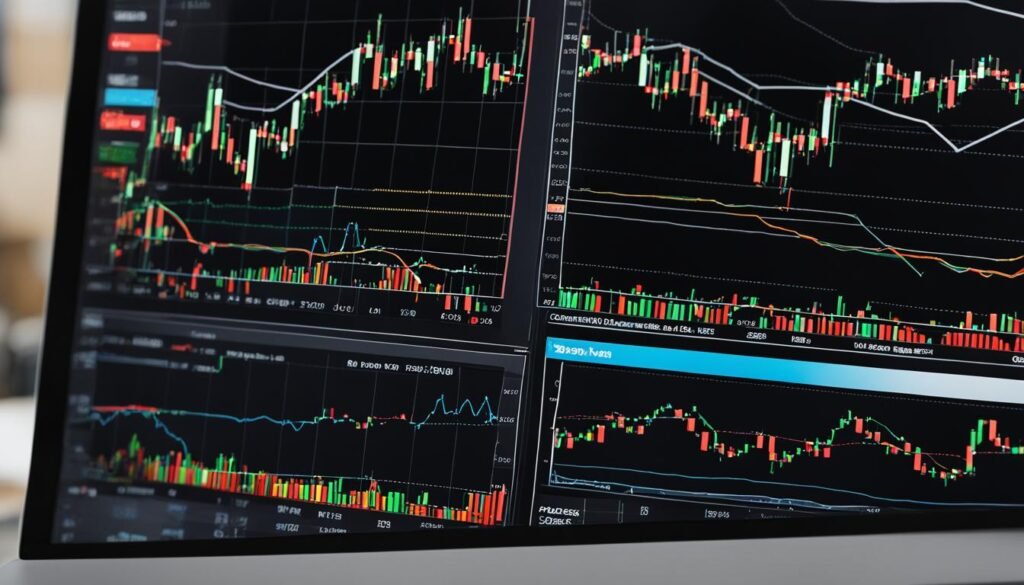When it comes to currency trading, relying solely on charts can be limiting. To gain a more comprehensive understanding of market dynamics, traders often use a blend of technical and fundamental analysis. Technical analysis involves analyzing past market data to identify patterns and trends, while fundamental analysis focuses on macroeconomic factors to assess the intrinsic value of a currency.
By combining these two approaches, traders can make more informed investment decisions that go beyond the charts. This can lead to developing more robust trading strategies and ultimately maximizing profitability. In this article, we’ll explore the benefits of blending technical and fundamental analysis in currency trading, as well as practical tips for implementing this approach.
Unlock the Secret to Forex Success with BOB James’ Top-Performing Signals! Experience the Ease of Proven, MyFXbook-Verified Strategies and Transform Your Trading Journey Today. Don’t Miss Out on Exceptional Performance – Join Now!
Key Takeaways:
- Blending technical and fundamental analysis can provide a more comprehensive view of the market.
- By using both approaches, traders can make more informed investment decisions beyond just relying on charts.
- Combining technical and fundamental analysis can lead to developing more robust trading strategies.
- Incorporating both approaches can help traders maximize profitability and manage risk more effectively.
- NLP analysis can also be used to gain insights into market trends and sentiment.
Understanding Technical Analysis
Technical analysis is an essential part of market analysis, helping traders to study past market data, identify patterns, and make informed investment decisions. It involves analyzing the historical price and volume data of a currency to forecast future price trends.
Tools and Indicators
Traders use various tools and indicators to perform technical analysis. Some common ones include:
- Moving averages: used to determine trends by smoothing out price fluctuations over a specific time period.
- Bollinger Bands: used to measure volatility and identify potential price breakouts and reversals.
- Relative Strength Index (RSI): used to assess overbought and oversold conditions of a currency.
- Fibonacci retracements: used to identify potential support and resistance levels.
By using these tools and indicators, technical analysts can gain insights into potential entry and exit points, as well as develop trading strategies that align with their risk management goals.
Trading Strategies
Technical analysis plays an important role in developing trading strategies. The goal is to identify trends and find trading opportunities in the market. Traders use technical analysis to determine the best time to enter and exit trades. Some popular trading strategies derived from technical analysis include:
- Bullish and bearish engulfing patterns: used to signal potential trend reversals.
- Breakout trading: capitalizing on price movements outside of established support and resistance levels.
- Swing trading: holding positions for several days to take advantage of short-term price fluctuation trends.
By combining technical analysis with fundamental analysis, traders can develop even more robust trading strategies that consider both market trends and economic factors that have an impact on currency valuations.
The Role of Technical Analysis in Currency Trading
Technical analysis helps traders understand market dynamics and make more informed trading decisions. By analyzing market data, traders can predict future market movements, recognize potential trend reversals, and make investments that reflect their risk management goals.

“Technical analysis is a way to understand the market in a more detailed way and find excellent opportunities to buy or sell a currency. By using technical analysis, traders can make decisions based on chart patterns and data, rather than emotions.”
Grasping Fundamental Analysis
Fundamental analysis is a cornerstone of currency trading, providing traders with a method to evaluate the economic strength of a currency. By examining economic indicators and key market drivers, traders can gain insights into the underlying value of a currency.
To conduct investment research, traders should analyze factors such as interest rates, GDP, and geopolitical events, to name a few. By evaluating these elements, traders can understand how they impact the intrinsic value of a currency.
| Economic Indicator | Description |
|---|---|
| Interest Rates | The cost of borrowing money and the return on lending money. |
| Gross Domestic Product (GDP) | The total market value of all goods and services produced by a country. |
| Geopolitical Events | Wars, elections, or other political events that can impact the economy. |
Understanding fundamental analysis is key for traders to gain a deeper understanding of the market dynamics and make more informed trading decisions based on market fundamentals rather than solely relying on technical indicators.

When combined with technical analysis (seen in section 2), fundamental analysis can provide traders with a comprehensive view of the market, strengthening trading strategies, and enhancing overall profitability.
The Power of Blending Technical and Fundamental Analysis
Blending technical and fundamental analysis can give traders a powerful edge when it comes to currency trading. By combining these two approaches, traders can gain a more comprehensive view of the market and make better trading strategies and investment decisions.
Technical analysis involves the use of various tools and indicators to analyze market trends and patterns. This approach can help traders to identify potential entry and exit points and develop effective trading strategies. On the other hand, fundamental analysis involves the analysis of economic factors, such as interest rates, GDP, and geopolitical events, to assess the intrinsic value of a currency.
When these two approaches are blended, traders can gain valuable insights into market dynamics that they might have missed with just one approach. Combining technical and fundamental analysis provides a well-rounded view of the market, which makes it easier for traders to make informed trading decisions.
Market analysis is an essential component of successful trading, and blending technical and fundamental analysis is an effective way to achieve a comprehensive analysis of the market. It empowers traders to explore all factors that may impact the currency market, providing valuable insights that can improve trading strategies and investment decisions.

By integrating technical and fundamental analysis techniques into trading strategies, traders can better manage risk and improve profitability. Furthermore, the role of investment research is essential in currency trading, and blended analysis is a valuable tool in this field.
The table below highlights some of the benefits of blending technical and fundamental analysis.
| Benefits of Blended Analysis | Description |
|---|---|
| Better Market Analysis | Informative view of market dynamics to improve trading strategies. |
| Improved Trading Strategies | Generate effective trading strategies, manage risk, and maximize returns. |
| Enhanced Investment Research | Gain valuable insights into market direction and currency trends, leading to informed investment decisions. |
Blended analysis offers traders a significant advantage in currency trading, providing a comprehensive view of the market and leading to better trading strategies and investment decisions. By combining technical and fundamental analysis, traders can gain valuable insights into market direction, currency trends, and potential trading opportunities, which can ultimately lead to higher profitability and success.
Developing a Blended Approach: The Role of NLP Analysis
In currency trading, the combination of technical and fundamental analysis provides a better understanding of market dynamics and aids in making informed investment decisions. To further enhance this blend, traders can leverage NLP (Natural Language Processing) analysis to extract valuable market insights from textual data.
NLP analysis involves the use of algorithms to understand human language. By processing news sentiment, social media data, and other textual information, traders can gain insights into market trends and sentiment. This type of data analysis complements traditional technical and fundamental analysis and provides a deeper understanding of market forces.
Many trading platforms offer NLP analysis tools, providing traders with valuable information to guide their investment decisions. For instance, ABC Trading Platform offers real-time news sentiment analysis, allowing traders to stay ahead of the market. By leveraging NLP analysis, traders can gain a competitive edge and maximize profitability.

“NLP analysis complements traditional market analysis by providing another layer of information that may not be visible through technical or fundamental analysis alone.”
Quantitative Analysis
NLP analysis enables traders to extract quantitative data from textual information. By using algorithms to categorize and classify language, traders can leverage data analysis techniques to gain insights into market trends. For instance, traders can analyze the frequency of certain words in news articles to predict market movements and make informed trading decisions.
Integration with Technical and Fundamental Analysis
NLP analysis is most effective when combined with traditional technical and fundamental analysis. By blending these approaches, traders can gain a more comprehensive view of the market and make well-informed investment decisions. For instance, by combining technical analysis with NLP analysis of news sentiment, traders can identify potential market trends early and act fast to capitalize on them.
Implementing Blended Strategies in Currency Trading
Blended strategies that incorporate both fundamental and technical analysis can be a game-changer in currency trading. By blending the two approaches, traders can gain a more comprehensive understanding of market dynamics and make more informed trading decisions.
When implementing blended strategies, traders need to first determine their trading style and risk appetite. Technical analysis can provide insights into potential entry and exit points, while fundamental analysis can help identify long-term value and market trends.
One way to blend technical and fundamental analysis is to use the technical analysis charts to identify entry and exit points, while using fundamental analysis to determine the overall trend of the market.
Another approach is to use stock market analysis techniques to enhance overall trading performance. By staying up-to-date on relevant news and events, traders can make more informed investment decisions.
Blended Strategies Example:
Trader X has extensive experience in both technical and fundamental analysis. Using a blended approach, he carefully examines the historical chart patterns (technical analysis) and economic indicators (fundamental analysis) to gauge the overall market trend. He also stays informed on the latest news and geopolitical events that might affect the market. By blending these strategies, he has been able to develop a reliable trading system that consistently generates profit.

“A blended approach can help traders gain a more comprehensive view of the market, leading to better trading strategies and investment decisions.”
Trend Analysis in Blended Approaches
Trend analysis is a crucial component of technical and fundamental analysis blending in currency trading. It involves examining historical and current market trends to identify patterns and forecast future price movements. By integrating trend analysis into the blending strategy, traders can gain valuable insights into market direction, making informed investment decisions.
Types of Trend Analysis Techniques
There are several techniques for trend analysis that traders can incorporate into their blended approach. These include:
- Simple Moving Averages: A moving average is the average price of an asset over a specific period. Traders use moving averages to identify price trends and potential entry and exit points.
- Exponential Moving Averages: Similar to simple moving averages but gives more weight to recent price data, allowing traders to quickly respond to market changes.
- Bollinger Bands: Bollinger Bands are used to identify overbought and oversold conditions in the market and help traders identify potential reversals in price.
- Price Channels: Price channels are used to identify key support and resistance levels and help traders make informed trading decisions.
By incorporating these and other trend analysis techniques, traders can gain a more comprehensive view of the market and enhance their trading strategies.
| Trend Analysis Techniques | Benefits |
|---|---|
| Simple Moving Averages | Identify price trends and potential entry and exit points |
| Exponential Moving Averages | Quickly respond to market changes |
| Bollinger Bands | Identify overbought and oversold conditions and potential price reversals |
| Price Channels | Identify key support and resistance levels for better trading decisions |
As the table illustrates, each trend analysis technique has its own unique benefits that traders can leverage in currency trading. By incorporating these techniques into a blended approach, traders can develop robust trading strategies, improve risk management, and make informed investment decisions.
Maximizing Profitability with Blended Analysis
Blended analysis combines technical and fundamental analysis to provide traders with a more comprehensive view of the market. This section explores how traders can leverage this approach to maximize profitability and make informed investment decisions.
Identifying Trading Opportunities
Blended analysis helps traders identify trading opportunities by providing multiple perspectives on the market. Technical analysis offers insights into price movements, while fundamental analysis provides an understanding of market sentiment. By blending these approaches, traders can identify entry and exit points with greater confidence.
Managing Risk
Managing risk is crucial in currency trading. Blended analysis can help traders manage risk by providing a more complete picture of the market. By understanding market trends and sentiment, traders can adjust their strategies to avoid potential losses.
Making Informed Investment Decisions
Blended analysis enables traders to make well-informed investment decisions. By combining both technical and fundamental analysis, traders can gain a deeper understanding of the market and make more strategic choices. This approach reduces the risk of making decisions based on incomplete or inaccurate data.
| Benefits of Blended Analysis | |
|---|---|
| Provides a holistic view of the market | Reduces the risk of making decisions based on incomplete or inaccurate data |
| Helps traders identify trading opportunities | Enables traders to make well-informed investment decisions |
| Allows traders to manage risk more effectively |
Blended analysis is a powerful tool to help traders maximize profitability. By combining technical and fundamental analysis, traders can gain a deeper understanding of the market and make more informed trading decisions. The integration of both approaches can help traders identify trading opportunities, manage risk, and make strategic investment decisions.
Conclusion
Blending technical and fundamental analysis is essential for successful currency trading. While technical analysis provides insights into market trends and patterns, fundamental analysis helps assess the intrinsic value of a currency by analyzing economic factors.
By combining these two approaches, traders gain a holistic perspective on the market, leading to better trading strategies and investment decisions. The integration of NLP analysis further enhances the blended approach by providing insights into market sentiment.
Trend analysis complements technical and fundamental analysis, providing traders with valuable insights into market direction. By identifying trading opportunities and managing risk, traders can maximize profitability using blended analysis techniques.
Going beyond relying solely on charts, traders are empowered to make well-informed investment decisions. The combination of technical and fundamental analysis provides a comprehensive view of the market through blended strategies.
In the dynamic world of currency trading, blending technical and fundamental analysis is the key to success.
Investors must implement these techniques into their trading strategies to make informed investment decisions and enhance their profitability.
The benefits of blending technical and fundamental analysis are clear, enabling traders to go beyond the charts and achieve success in the thrilling world of currency trading.
Start implementing blended analysis techniques in your trading strategies today to enhance your overall trading performance and make well-informed investment decisions.
Remember, success in currency trading is not just about the numbers; it’s about understanding the market and making well-informed decisions.
So, blend your technical and fundamental analysis, develop your trading strategies, and make your investment decisions based on a comprehensive view of the market.
Start today, and see your currency trading success soar!
FAQ
What is technical analysis?
Technical analysis is a method used to examine market data, such as historical prices and trading volume, to identify patterns and trends. It involves the use of various tools and indicators to predict future price movements and make trading decisions.
What is fundamental analysis?
Fundamental analysis is a strategy used to evaluate the intrinsic value of a financial asset, such as a currency. It involves analyzing economic indicators, company financials, and geopolitical factors to determine the asset’s true worth and make informed investment decisions.
How can I blend technical and fundamental analysis in currency trading?
To blend technical and fundamental analysis, you can use technical indicators and patterns to identify potential trading opportunities, and then use fundamental analysis to confirm the validity of those opportunities based on economic factors and market sentiment.
What is the benefit of blending technical and fundamental analysis?
Blending technical and fundamental analysis provides a more comprehensive view of the market. It combines insights from both approaches, allowing traders to make more informed trading decisions and develop robust strategies that consider both market trends and underlying economic conditions.
How can NLP analysis be integrated into blended analysis?
NLP (Natural Language Processing) analysis can be integrated into blended analysis by analyzing news sentiment, social media data, and other textual information to gain insights into market trends and sentiment. This can further enhance the accuracy of trading decisions and provide a deeper understanding of market dynamics.
How do I implement blended strategies in currency trading?
To implement blended strategies, you can combine technical and fundamental analysis in your trading approach. Use technical indicators and patterns to identify potential trades, then evaluate the fundamental drivers behind those trades to confirm their viability. This integration allows for a more well-rounded trading strategy.
What role does trend analysis play in blended approaches?
Trend analysis is an important aspect of blended approaches. It helps traders identify and follow market trends, which can be valuable in confirming technical patterns and supporting fundamental analysis. Trend analysis provides insight into the overall direction of the market, aiding traders in making more accurate trading decisions.
How can I maximize profitability with blended analysis?
To maximize profitability, traders can leverage blended analysis by combining technical and fundamental analysis to identify high-probability trading opportunities. By using both approaches, traders can manage risk more effectively, make informed investment decisions, and enhance their overall trading performance.
What are the benefits of blending technical and fundamental analysis in currency trading?
Blending technical and fundamental analysis in currency trading allows traders to gain a deeper understanding of market dynamics. It provides a more comprehensive view of the market, enhances trading strategies, and allows for more informed investment decisions based on both market trends and underlying economic factors.


